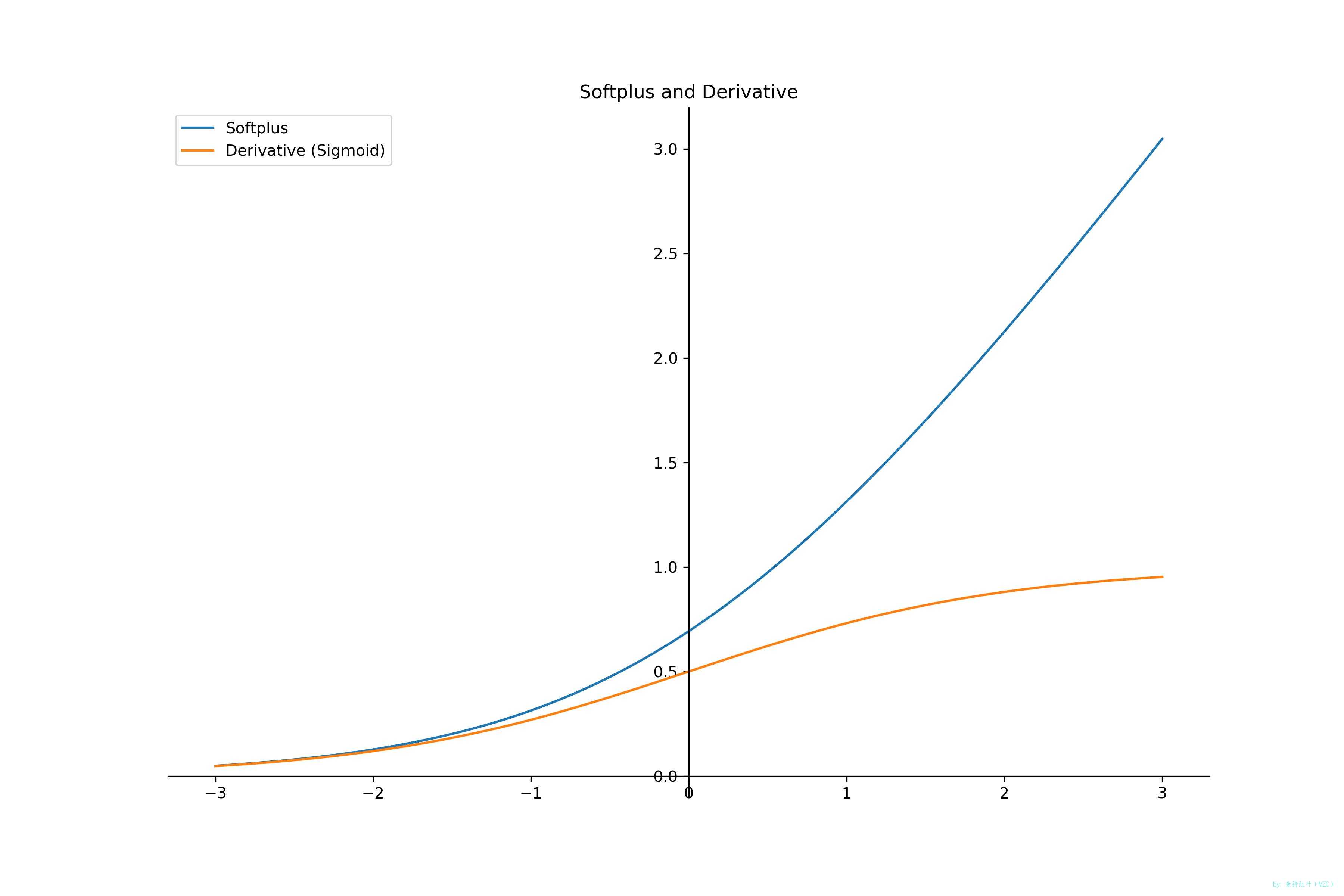Softplus
函数+导函数
Softplus函数
Softplus ( x ) = ln ( 1 + e x ) \begin{aligned} \operatorname{Softplus}(x) &= \ln \bigl(1 + e^{\,x}\bigr) \end{aligned} Softplus(x)=ln(1+ex)Softplus函数导数
d d x Softplus ( x ) = d d x ln ( 1 + e x ) = 1 1 + e x ⋅ e x = e x 1 + e x = e x 1 + e x ⋅ e − x e − x = 1 1 + e − x = σ ( x ) \begin{aligned} \frac{d}{dx}\operatorname{Softplus}(x) &=\frac{d}{dx}\ln\!\left(1+e^{x}\right)\\ &=\frac{1}{1+e^{x}}\cdot e^{x}\\ &=\frac{e^{x}}{1+e^{x}}\\ &=\frac{e^{x}}{1+e^{x}} \cdot \frac{e^{-x}}{e^{-x}}\\ &=\frac{1}{1+e^{-x}}\\ &=\sigma(x) \end{aligned} dxdSoftplus(x)=dxdln(1+ex)=1+ex1⋅ex=1+exex=1+exex⋅e−xe−x=1+e−x1=σ(x)
其中, σ ( x ) = 1 1 + e − x \sigma(x)=\dfrac{1}{1+e^{-x}} σ(x)=1+e−x1 是 sigmoid 函数。Softplus 处处可导,并且导数恰好是 sigmoid。
函数和导函数图像
画图
import numpy as np from matplotlib import pyplot as plt # Softplus 函数 def softplus(x): return np.log1p(np.exp(x)) # Softplus 的导数 = sigmoid def softplus_derivative(x): return 1 / (1 + np.exp(-x)) # 生成数据 x = np.linspace(-6, 6, 1000) y = softplus(x) y1 = softplus_derivative(x) # 绘图 plt.figure(figsize=(12, 8)) ax = plt.gca() plt.plot(x, y, label='Softplus') plt.plot(x, y1, label='Derivative (Sigmoid)') plt.title('Softplus and Derivative') # 去边框 ax.spines['right'].set_color('none') ax.spines['top'].set_color('none') ax.xaxis.set_ticks_position('bottom') ax.spines['bottom'].set_position(('data', 0)) ax.yaxis.set_ticks_position('left') ax.spines['left'].set_position(('data', 0)) plt.legend() plt.savefig('./softplus.jpg',dpe=300) plt.show()3
优缺点
Softplus 的优点
- 平滑处处可导:Softplus 是 ReLU 的光滑近似,没有折点,避免了 ReLU 在 0 处不可导的问题。
- 梯度不消失:对于任意输入,梯度始终为正,并且随输入增大趋近于 1,有效缓解梯度消失。
- 解析形式简单:公式简洁,易于实现,且与 sigmoid 有天然联系。
- 连续可导:在需要二阶导数或高阶导数的场景(如 Hessian、自然梯度)中更容易处理。
Softplus 的缺点
- 计算开销:相比 ReLU 的逐位最大值操作,Softplus 需要计算指数和对数,计算量更大。
- 输出始终为正:当需要负激活值时(如残差网络中的负值路径),Softplus 无法提供。
- 边缘饱和:当输入为很大的负数时,Softplus 会趋于 0,虽然比 sigmoid 缓解,但仍可能带来梯度衰减。
- 超参数敏感:在部分任务中需要额外调整初始化或学习率,以抵消其非零均值的副作用。
PyTorch 中的 Softplus 函数
代码
import torch import torch.nn.functional as F # 使用 PyTorch 自带的 Softplus sp = F.softplus x = torch.tensor([-2.0, 0.0, 2.0]) y = sp(x) print("x :", x) print("softplus(x):", y) """输出""" x : tensor([-2., 0., 2.]) softplus(x): tensor([0.1269, 0.6931, 2.1269])
TensorFlow 中的 Softplus 函数
环境
python: 3.10.9
tensorflow: 2.19.0
代码
import tensorflow as tf softplus = tf.keras.activations.softplus x = tf.constant([-2.0, 0.0, 2.0]) y = softplus(x) print("x :", x.numpy()) print("softplus(x):", y.numpy()) """输出""" x : [-2. 0. 2.] softplus(x): [0.12692805 0.6931472 2.126928 ]